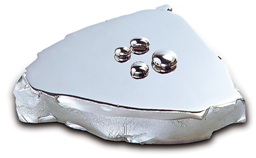Why we shouldn't get too excited about a 'Liquidmetal' iPhone 5

The shell of the iPhone 4 and 4S is constructed of robust stainless steel sandwiched between two sheets of fragile glass. It's a revolutionary design, but one that has caused a lot of heartache and expense for owners.
According to a rumor that surfaced last week, this could change with the next-generation iPhone, where the vulnerable rear glass panel will be replaced with a robust Liquidmetal shell.

In August 2012, Apple acquired a license to use this material, but has yet to use it for anything more exciting than the iPhone's SIM card eject tool.
I've come across Liquidmetal before: a SanDisk Cruzer Titanium USB flash drive. SanDisk also used Liquidmetal in the construction of the now long defunct Sensa e200 media player.
It's incredibly tough stuff, and I really tested the durability of that flash drive. Short of taking a hammer to it, I could barely put a scratch, let alone a dent, in the thin shell surrounding the drive's delicate electronics.
There's no doubt that Liquidmetal is incredibly tough stuff. You might think that a Liquidmetal iPhone 5 would be a near-indestructible piece of kit?
Wrong.
| Image Gallery: What is Liquidmetal used for? | ||||||
Liquidmetal is, as you can see from the video below, excellent at storing elastic energy. This, to you and me, means the material likes to bounce about with Flubber-like vigor when dropped.
I've seen this property in action. That SanDisk Cruzer Titanium flash drive I had would bounce enthusiastically whenever dropped onto a hard surface. A bouncing flash drive is one thing, but a bouncing iPhone is another, and likely to suffer more overall damage than one that just thuds to the ground because each bounce is another chance for gravity to break the screen.
I don't think that it is Liquidmetal's indestructibility that Apple is interested in, because let's face it, Apple doesn't have a track record of building robust devices, but instead the material's high strength-to-weight ratio that interests the Apple engineers.
This property means that you can cast a shell out of Liquidmetal that's much thinner than a shell stamped out of a sheet of metal, as was the case with the early iPhones, or machined out of a block of aluminium, which is how Apple manufactures the shells of devices such as the MacBooks or iPads. A thinner shell means less space taken up per unit volume by the casing, which in turn leaves more space for the important stuff that goes inside the device.
But there's one property of Liquidmetal that no one seems to have considered. How transparent is this material to radio frequencies?
If the material doesn't allow for effective passage of radio frequencies, moving all the iPhone's antennas -- GSM, CDMA, UMTS, GPS, Wi-Fi, and Bluetooth -- inside a Liquidmetal shell doesn't make sense. I've had a look through the tech specs for the material but can't find anything relating to this. I've put a question in to Liquidmetal Technologies about radio frequency transmission, and will update this post if I get an answer.
Image credit: Liquidmetal Technologies.
Related:
Top accessories for your iPhone and iPad
| Image Gallery: Top accessories for your iPhone and iPad | ||||||
- Valve: "No one here was meeting with Tim Cook"
- How to get AT&T to unlock your off-contract iPhone
- AT&T to allow unlocking of off-contract iPhones
- 600,000 apps in Apple's App Store, yet I can't find anything I want
- 100 reasons to jailbreak an iPhone
- Half of US households own an Apple product
- Smartphones account for half of all mobile phones in the US
- iPhone 4 owners can now pick up $15 ‘Antennagate' settlement